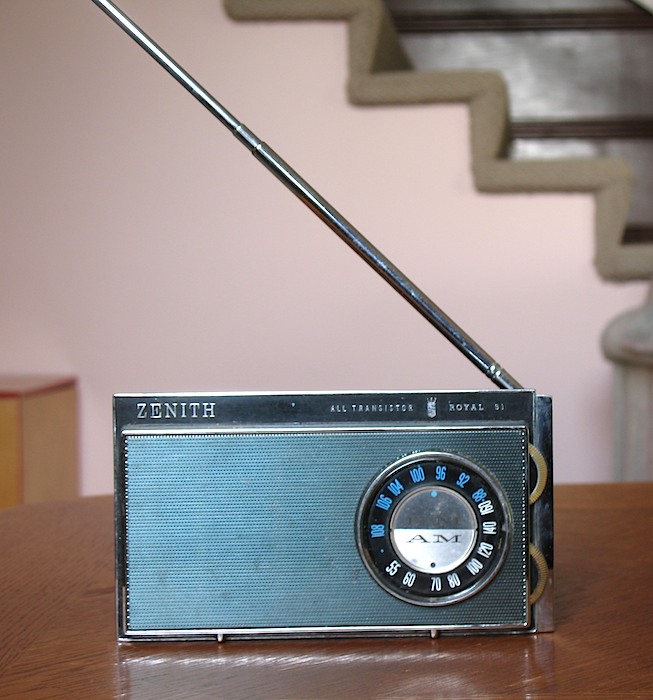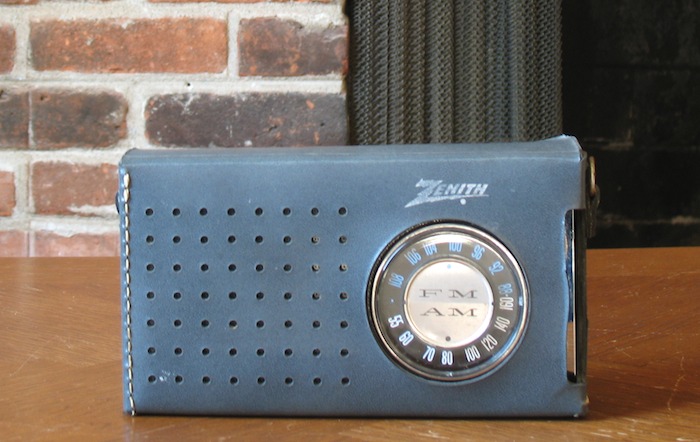
At the same time that the Zenith Royal 820 "Symphony" model was brought to market in 1964, Zenith also began selling its smallest AM/FM radio up to that time: the Royal 810, dubbed the "Symphonette". The numbering and the naming might give you the idea that it's just a smaller version of the Royal 820 (later called the Royal 76), but it wasn't.
One obvious fact tells you that the circuitry has to be different: the battery configuration was different. The 820 needed six cells (for nine volts altogether) while the 810 needed four (for six volts). There was one less transistor in the 810, though that might have just meant that the audio circuitry was different, and less powerful.
In the great Great Zenith Renumbering of 1967, the Royal 810 became the Royal 51, which is the model pictured here. Judging by the web sites of retailers who sell service manuals for the radio, it went through at least five different chassis configurations. The model pictured here is the Royal 51-1, chassis 9XT4123.
The Royal 810/51's performance wasn't up to the same level as the 820/76, based on my observations with my Royal 51, comparing it to my two Royal 76's. The 51 is less sensitive on both AM and FM, and is less selective on FM as well. I have seen some raves about the 810 or 51; either those folks aren't as picky as I am (especially about FM performance), or I have a unit in need of refurbishing. I actually doubt the latter, though: for a few weeks in 2011, I had the use of a Zenith Royal 810 that was refurbished, and its performance was only slightly better than the Royal 51.
On my slightly more objective scale, I'd describe AM sensitivity as good. It's a reasonable performer, but not up to the level of a Royal 76. As usual, Zenith made the tradeoff between sensitivity and sound quality in favor of better sound; even so, the Royal 51 has more of a "transistor radio" sound that the Royal 76. That's not surprising; it's a smaller radio, with a smaller speaker and less powerful audio output.
On FM, I'd only rate this radio as fairly good (recall that this is a lower rating than "good"). It is free from overload, but it's best only for strong local signals. I have two benchmarks that I use in comparing FM radios. First, can the radio get many or most of the lower-powered stations in the "educational" part of the band (88-92 MHz)? Second, can it get the San Jose-based signals that are on alternate channels to the central Bay Area frequency allocations. The Royal 76 does very well on the first test, and slightly better than average on the second. The Royal 51 doesn't do well on either test. It's OK for local signals.

One thing this radio does do well on FM relates to the way its antenna is constructed. It feels like it's spring-loaded. So the antenna will stay in position with very little effort.
It's also built well. Especially with 4 "AA" batteries installed, the radio feels solid.
Tuning is not particularly well-calibrated. While it's nice that Zenith didn't use the slide-rule method for tuning all its radios, the circular dial used on this model is hard to read.
The radio also can accept an AC adapter, not included, and it came with a fake-leather "Permawear" case. Mine has its case, in a mousy gray color. I hope the color looked better when it was new.
The Royal 51 appears to have been made as long as the Royal 76 was made, which would mean that it was available through at least 1968, and possibly into 1969.
I wish I could say better things about it, because it's beautifully built, just as are the domestically made Zeniths, and has a distinctive appearance. But the performance is ordinary, probably due to the compromises required as a consequence of its compact design.